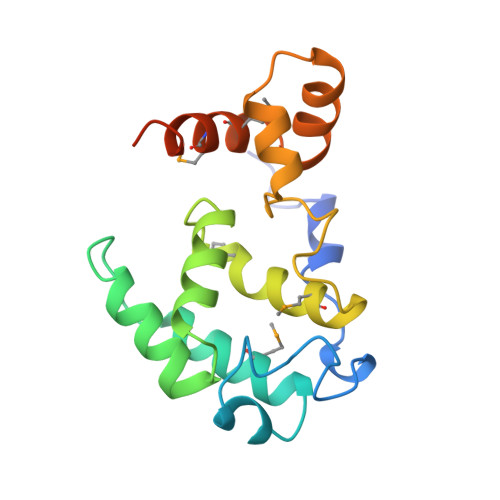Structural and functional studies of the Rap1 C-terminus reveal novel separation-of-function mutants.
Feeser, E.A., Wolberger, C.(2008) J Mol Biol 380: 520-531
- PubMed: 18538788
- DOI: https://doi.org/10.1016/j.jmb.2008.04.078
- Primary Citation of Related Structures:
3CZ6 - PubMed Abstract:
The yeast Rap1 protein plays an important role in transcriptional silencing and in telomere length homeostasis. Rap1 mediates silencing at the HM loci and at telomeres by recruiting the Sir3 and Sir4 proteins to chromatin via a Rap1 C-terminal domain, which also recruits the telomere length regulators, Rif1 and Rif2. We report the 1.85 A resolution crystal structure of the Rap1 C-terminus, which adopts an all-helical fold with no structural homologues. The structure was used to engineer surface mutations in Rap1, and the effects of these mutations on silencing and telomere length regulation were assayed in vivo. Our surprising finding was that there is no overlap between mutations affecting mating-type and telomeric silencing, suggesting that Rap1 plays distinct roles in silencing at the silent mating-type loci and telomeres. We also found novel Rap1 phenotypes and new separation-of-function mutants, which provide new tools for studying Rap1 function. Yeast two-hybrid studies were used to determine how specific mutations affect recruitment of Sir3, Rif1, and Rif2. A comparison of the yeast two-hybrid and functional data reveals patterns of protein interactions that correlate with each Rap1 phenotype. We find that Sir3 interactions are important for telomeric silencing, but not mating type silencing, and that Rif1 and Rif2 interactions are important in different subsets of telomeric length mutants. Our results show that the role of Rap1 in silencing differs between the HM loci and the telomeres and offer insight into the interplay between HM silencing, telomeric silencing, and telomere length regulation. These findings suggest a model in which competition and multiple recruitment events modulate silencing and telomere length regulation.
Organizational Affiliation:
Department of Biophysics and Biophysical Chemistry, Johns Hopkins University School of Medicine, Baltimore, MD 21205-2185, USA.

















